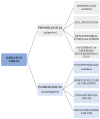Pt(IV) Complexes as Anticancer Drugs and Their Relationship with Oxidative Stress
- PMID: 40299672
- PMCID: PMC12024748
- DOI: 10.3390/biomedicines13040981
Pt(IV) Complexes as Anticancer Drugs and Their Relationship with Oxidative Stress
Abstract
Despite continuous research, cancer is still a leading cause of death worldwide; therefore, new methods of cancer management improvement are emerging. It is well known that in the pathophysiology of cancer, oxidative stress (OS) is a significant factor. Nevertheless, there is currently no quick or easy way to identify OS in cancer patients using blood tests. Currently, in cancer treatments, Pt(IV) complexes are preferred to Pt(II) complexes in terms of adverse effects, drug resistance, and administration methods. Intracellular reductants convert Pt(IV) complexes to their Pt(II) analogs, which are Pt compounds with anti-carcinogenic effects. Our aim was to find out if Pt(IV) complexes could be used to assess blood oxidative stress indicators and, consequently, monitor the development of cancer. In this review, we analyzed previous research using the PubMed and Google Scholar public databases to verify the potential use of Pt(IV) complexes in cancer management. We found that two main serum antioxidants, glutathione and ascorbic acid, which are easily measured using conventional methods, react favorably with Pt(IV) complexes. Our research results suggest Pt(IV) complexes as therapeutic anticancer drugs and potential diagnosis agents. However, further research must be conducted to verify this hypothesis.
Keywords: Pt(IV); anticancer prodrugs; ascorbic acid; cancer; glutathione; oxidative stress.
Conflict of interest statement
The authors declare no conflicts of interest.
Figures





Similar articles
-
Cancer-Specific, Intracellular, Reductive Activation of Anticancer PtIV Prodrugs.Chemistry. 2017 Apr 27;23(24):5678-5681. doi: 10.1002/chem.201701192. Epub 2017 Apr 5. Chemistry. 2017. PMID: 28319647
-
Influence of reducing agents on the cytotoxic activity of platinum(IV) complexes: induction of G2/M arrest, apoptosis and oxidative stress in A2780 and cisplatin resistant A2780cis cell lines.Metallomics. 2015 Jul;7(7):1078-90. doi: 10.1039/c5mt00116a. Metallomics. 2015. PMID: 26073554
-
Photoactivatable platinum complexes.Anticancer Agents Med Chem. 2007 Jan;7(1):75-93. doi: 10.2174/187152007779314053. Anticancer Agents Med Chem. 2007. PMID: 17266506 Review.
-
A Ratiometric Fluorescent Probe for Cisplatin: Investigating the Intracellular Reduction of Platinum(IV) Prodrug Complexes.Angew Chem Int Ed Engl. 2019 Jan 2;58(1):164-167. doi: 10.1002/anie.201810361. Epub 2018 Dec 4. Angew Chem Int Ed Engl. 2019. PMID: 30407697
-
Beyond mere DNA damage: Recent progress in platinum(IV) anticancer complexes containing multi-functional axial ligands.Curr Opin Chem Biol. 2023 Jun;74:102303. doi: 10.1016/j.cbpa.2023.102303. Epub 2023 Apr 17. Curr Opin Chem Biol. 2023. PMID: 37075513 Review.
References
-
- World Health Organization Global Cancer Burden Growing, Amidst Mounting Need for Services. Feb 1, 2024. [(accessed on 1 January 2025)]. Available online: https://www.who.int/news/item/01-02-2024-global-cancer-burden-growing--a....
-
- Global Surg Collaborative and National Institute for Health Research Global Health Research Unit on Global Surgery Global variation in postoperative mortality and complications after cancer surgery: A multicentre, prospective cohort study in 82 countries. Lancet. 2021;397:387–397. doi: 10.1016/S0140-6736(21)00001-5. - DOI - PMC - PubMed
-
- Corrie P.G. Cytotoxic chemotherapy: Clinical aspects. Medicine. 2008;36:24–28. doi: 10.1016/j.mpmed.2007.10.012. - DOI
Publication types
Grants and funding
LinkOut - more resources
Full Text Sources

